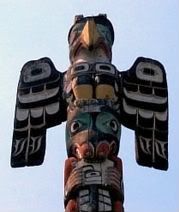
Thunderbird Totem from Wikipedia
Hey, H&H just took a road trip of college campuses. We think we're gonna hop in the ol' heap and take another cross-state spin, this time in search of creepy critters. Every state has an unexplained spooky, scaly saurian of some sort in its woods or waters.
We've already done a pair of Pennsylvania's macabre mutts, Boo-Boo Bridge's Suscon Screamer and Chickie Rock's Albawitches. Now we're after the fearsome Thunderbird.
The Thunderbird isn't a johnny-come-lately to the cryptozoid party. There have been sightings dating back way before Europeans set eyes on the Promised Land. Its winged figure has been painted on rocks and has adorned the totems of Native American lodges from sea to shining sea for centuries before the Pilgrims dropped anchor.
According to the myths, the giant Thunderbird could shoot lightning from its eyes and its wings were so enormous that they created peals of thunder when they flapped, creating storms as they flew by.
For the tribes of the local Iroquois Confederacy, Hino, the Thunderbird, was the guardian of the skies and the spirit of thunder, and could assume the form of a human when it wished.
They believed that the Thunderbirds could morph into human form by tilting back their beaks like a mask, and removing their feathers as if they were a blanket. In fact, there is lore of Thunderbirds in human form marrying into Native American families, and some tribes trace their lineage to T-Birds.
One tale tells of a clan of Thunderbirds in human form that lived along the northern tip of Vancouver Island. Other short-memoried tribes forgot the true nature of these Thunderbird families, and took them as slaves in their human shape. The Thunderbirds put on their feathers, straightened their beaks, and reverted to form to wreak vengeance upon their captors. Ah, payback...
Now there's some debate concerning the intentions of these giant birds. Some tribal legends paint them as guardians and a good omen; others consider them war-like and predatory. One thing that both sets of tales agree on is that friendly or not, you don't want to get on the bad side of a Thunderbird.
In the legends of the Miami tribe, the birds interloped while they were fighting their traditional foes, the Mestchegamies. As the battle was reaching its climax, two Thunderbirds emerged from their lair, and each snatched a Miami war chief in its talons. The Miamis dropped their weapons and fled, never to return, believing that the Great Spirit had sent the birds to help their enemies.
But the victory was double-edged. Soon after the Thunderbirds had flown off with the Miami warriors, whom they presumably devoured, the T-Birds developed a taste for human flesh. As a result, the Mestchegami paid for their conquest by having to provide regular sacrifices of their kin to sate the appetite of the Thunderbirds.
OK, OK, what about Pennsylvania? Though spotted all over the country, and for that matter, the world, no place comes close to the number of Thunderbird reports as does Pennsylvania. The Keystone State's Thunderbird stories have been traced well into the nineteenth century.
Most of the sightings come from the Black Forest region of Clinton, Potter, Lycoming, Tioga, Cameron, and McKean counties, sparsely populated areas of mainly state forests and gamelands.
Southwest Pennsylvania is another prime spot for Thunderbird watchers. Both are naturals, as the Thunderbird of legend doesn't live in an aerie, but prefers caves or mines.
Just this decade, there have been reports of Thunderbirds from South Greensburg, Erie, and Greenville. Older reports come from Bear Run, Beaver Falls, Centerville, Coudersport, Dents Run, Hammersley Forks, Hyner, Jersey Shore, Kettle Creek, Little Pine Creek, Lock Haven, Murrysville, Ole Bull, Renova, Shingletown, Sunderlinville...well, you get the picture.
Some of these sightings have been quite lengthy, one lasting 20 minutes. Several souls have seen the Thunderbird close up, either perched in a sturdy tree or hovering low overhead.
And surprisingly, most have been fairly quiet meetings; it seems that the storm birds of Six Nation myth prefer to glide through the sky, although one person described the flapping wings as making a noise like flags snapping in a strong wind.
It's hard to miss one or confuse it with an eagle or vulture. The Thunderbird has been described as having a 15-20' wingspan, standing 4-8' tall, and being dark colored; brown, gray, or black. And that description has held true pretty consistently, no matter who's spotted the Big Bird.
The largest wingspan known for a documented living bird is that of the wandering albatross, with a wingspan to 12 feet. The Andean and the California condor have wingspans of 10 feet. Many biologist believe that the Thunderbird may be a throw-back of the Condor family.
Others have posited that it's a modern day pterodactyl cousin, but until one is captured, we'll never know. There was supposed a picture taken of one in Texas years ago that was printed in a newspaper or magazine, and while many have claimed to see the photo, no one's ever found the published shot.
The most terrifying story about Thunderbirds is that they occasionally attempt to carry away family pets or children. None of those tales originated in Pennsylvania, although there have been reports of seeing the bird snatch small deer for a snack.
But if you do run across one and have Junior or Fido with you, head for cover. Remember that old Miami myth...?

3 comments:
There was a story posted about 20 years ago in the "Steppin Out" about a guy in Centerville or that area, that had none in captivity in the early 1900s. I've tried to find this story online but have yet to find it
My husband saw one last week. He said he was eyeing him like it wanted to snatch him. It freaked him out. It was outside his job parking lot at 1130pm in Allentown PA.
We were just taking about that
Post a Comment